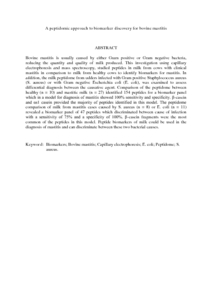Citation
Mansor, Rozaihan and Mullen, William and Albalat, Amaya and Panagiotis, Zerefos and Harald, Mischak and Barret, David C. and Andrew, Biggs and Eckersall, P. D.
(2013)
A peptidomic approach to biomarker discovery for bovine mastitis.
Journal of Proteomics, 85.
pp. 89-98.
ISSN 1874-3919; ESSN: 1876-7737
Abstract
Bovine mastitis is usually caused by either Gram positive or Gram negative bacteria, reducing the quantity and quality of milk produced. This investigation using capillary electrophoresis and mass spectroscopy, studied peptides in milk from cows with clinical mastitis in comparison to milk from healthy cows to identify biomarkers for mastitis. In addition, the milk peptidome from udders infected with Gram positive Staphylococcus aureus (S. aureus) or with Gram negative Escherichia coli (E. coli), was examined to assess differential diagnosis between the causative agent. Comparison of the peptidome between healthy (n = 10) and mastitic milk (n = 27) identified 154 peptides for a biomarker panel which in a model for diagnosis of mastitis showed 100% sensitivity and specificity. β-casein and αs1 casein provided the majority of peptides identified in this model. The peptidome comparison of milk from mastitis cases caused by S. aureus (n = 8) or E. coli (n = 11) revealed a biomarker panel of 47 peptides which discriminated between cause of infection with a sensitivity of 75% and a specificity of 100%. β-casein fragments were the most common of the peptides in this model. Peptide biomarkers of milk could be used in the diagnosis of mastitis and can discriminate between these two bacterial causes.
Download File
![[img]](http://psasir.upm.edu.my/29909/1.hassmallThumbnailVersion/A%20peptidomic%20approach%20to%20biomarker%20discovery%20for%20bovine%20mastitis.pdf)  Preview |
|
PDF (Abstract)
A peptidomic approach to biomarker discovery for bovine mastitis.pdf
Download (184kB)
| Preview
|
|
Additional Metadata
Actions (login required)
 |
View Item |

